Etymology
Variants of the term "Moor" have been used by many Europeans since ancient times as a general description for indigenous Africans. Contrary to popular belief, the term is not synonymous with "Islamic" or any specific Arab or African religion, civilization, or ethnicity.
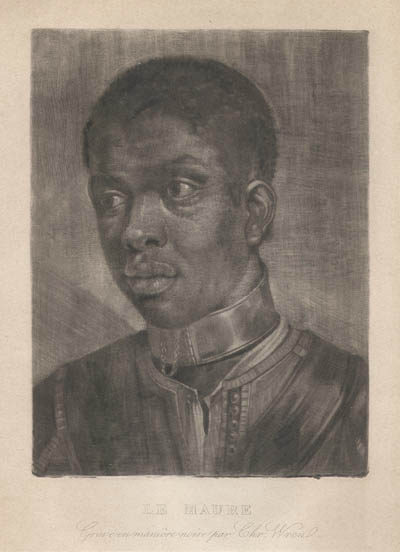 |
The origin of the English term, "Moor," is the Greek word, "μαυρο" or "mavro" which literally means "black, blackened or charred" and has long been used to describe black or very dark things such as, "Mavri Thalassa" which refers to the Black Sea or "mavri spilia" which means "black cave." Ancient Greeks used the term to describe the complexion of Africans and (even today, some Greeks use "mavro" to refer to Africans, although in a pejorative manner).
One need not be a linguist to see the word's evolution from the Greek "mavro" to the Latin word, "mavrvs" (actually, "mavro" in the ablative, singular, masculine Latin form). The English transliteration is "Maurus" and the plural form is "Mauri," specifically used by ancient Romans in reference to Black Africans. Writers in both Greek and Latin specifically used the term as a racial identity. In theEpitome de Caesaribus (390s AD), we learn that Aemilianus was "a Moor by race." Procopius of Caesarea (500-565 AD), a Byzantine scholar who wrote in Greek, said in his History of the Wars, "beyond that there are men not black-skinned like the Moors..."
Even through the middle ages, the term (as well as the Spanish, "moro," the German "mohr," the Dutch "moor" etc.) continued to be used in reference to Black Africans. In one of the oldest Dutch texts (1300s AD), a Moor was described specifically as "black."
Further proof of the true definition of the Latin term "Maurus" can be found in early English-Latin dictionaries:
- "Maurus" was synonymous with "Moor," "negro," and "Aethiops" in John Etick's A new English-Latin dictionary (1783)
- In A new Latin-English dictionary by William Young (1810), "Maurus" is a "black Moor"
- According to the Ainsworth's Latin Dictionary, Morell's abridgment by Alexander Jamieson, Robert Ainsworth (1828), "Maurus" means "black Moor"
The English term "Moor" also meant "Black" in English dictionaries and encyclopaediae prior to the 20th century:
- "Moor" meant "negro" or "black-a-moor" in A Dictionary of the English Language (1768) by Samuel Johnson
- The Encyclopaedia Londinensis (1817) by John Wilkes lists "moor" as follows: "[maurus, Lat. μαυρο, Gr., black.] a negro; a blackamoor."
- John Olgilvie's The Imperial Dictionary of the English Language (1882), a Moor was a "black man or negro"
Somehow by the 20th century, "Maurus" and "Moor" suddenly transformed into Berber and Arab -- a grave contrast to historical precedent.
Moors In Ancient and Medieval European History
 |
The ancient Romans thoroughly documented the lives of indigenous Africans to whom they commonly referred as the Moors. By the 4th century AD, the Roman army heavily recruited Moors for their exceptional skill in battle. One such Moorish general, Aemilianus (207-253 AD) as described in Epitome de Caesaribus (390s AD), was so skilled that he was made emperor in the Roman province of Moesia (Balkan peninsula), albeit for only 4 months' time.
Other skilled Africans were made Catholic patron saints, such as the popular St. Maurice or Mauritius in Latin as described in the Passio Martyrum Acaunensium (The Passion of the Martyrs of Agaunum) by French bishop St. Eucherius (434-450 AD). According to the text, St. Maurice lived around 286 AD and was believed to be part of the Theban Legion of Egyptian Christians who served in the Roman army under his command. St. Maurice's brigade was supposedly decimated for disobeying orders to kill Christians in Roman Helvetia (Switzerland). The oldest known physical representation of him, however, was not created until 1281 AD (a detailed statue now housed in the cathedral of Magdeburg, Germany; shown on the right).
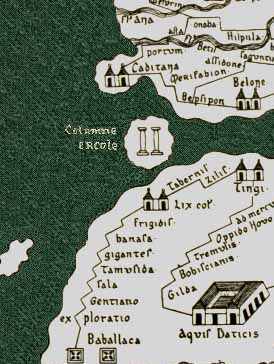 |
Neither Aemilianus nor St. Maurice were from so-called "Mauretania" (Latin: Mavritania) which is erroneously believed to be the name of an ancient Roman province along the northwestern coast of Africa. This particular region was neither called "Mauretania" in any known ancient literary text nor was it named after the so-called "Mauri tribe," as many modern historians believe. "Mauri" is merely the plural form of the Latin transliteration, "Maurus," as mentioned above. The oldest known map of that region (shown at right) shows its name was Tingi (or Tingitana in literature). Instead, Roman Catholic writers of the 5th-9th centuries AD used "Mauretania" synomymously with all of Africa, not any one particular region.
A well-known Catholic saint from Africa was Victor Maurus or Saint Victor the Moor, a martyr who supposedly lived around 303 AD (the date of the oldest known depiction of him might not be reliable since the church in which it is found, the Basilica of Saint Victor near Milan, was reconstructed several times and then nearly destroyed in World War II). The life of another African Catholic martyr, St. Zeno of Verona, was first recounted by 7th century Italian author, Coronato who affirmed that Zeno was an African native.
By 470 AD, following the fall of the Roman empire, Africans slowly began repopulating southern Europe, and by 711 AD, General Tarik ibn Ziyad al-Gibral, an Islamized African native whence the name, "Gibraltar," is derived, led a major invasion beyond that same peninsula. His fortress (shown below) is the earliest known medieval castle in Europe, built centuries before those of the Loire Valley in France. According to legend, the phrase, "Thank heaven for 711" comes from the overwhelming sentiment of relief experienced when Moorish civilization permeated the Iberian peninsula (Spain, Portugal and Andorra) and Southern France and replaced primitive Visagothic feudal serfdom. For over 750 years, the Moors would lead Spain into an unprecedented era of freedom of association, religion, education and enterprise.
 |
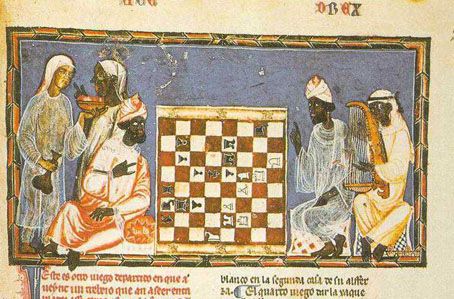 |
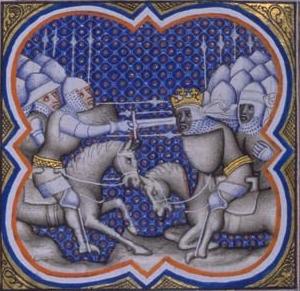 |
By 800 AD, the Franks began efforts to contain the spread of Moorish society to the south of the Pyrennees mountains. Much of the literature, lore and art that followed centered around the Franks' efforts to defeat the Moors. For instance, the Song of Roland(French, La Chanson de Roland, 1140-1170 AD), the oldest known French literary work, describes Frankish Charlemagne's (742-814 AD) long campaign in southern France. The text's account of a Moorish leader named Marsile, is as follows:
"Although Marsile has fled, his uncle Marganice remains, he who rules Carthage, Alfrere, Garmalie, and Ethiopia, an accursed land. He has the black people under his command, their noses are big and their ears broad, together they number more than fifty thousand. They ride fiercely and furiously, then they shout the pagan battle cry."
Then another African general whom the Franks called Abisme is described as follows: "In the forefront rides a Saracen, Abisme...He is as black as molten pitch."
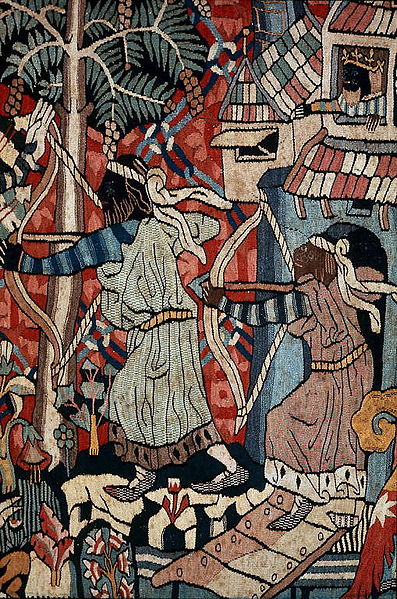 |
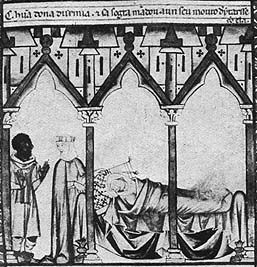 |
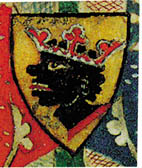 |
There were also several accounts of Moors in northern and central Europe, including that of the so-called "Freising Moor." The oldest known use of his image on any coat of arms was created around 1300 AD by Bishop Emicho of Wittelsbach in Skofja Loka, Slovenia. The town of Freising, Germany's oldest known coat of arms dates to 1362, which included the head of the Moor along with the bear he supposedly defeated while traveling with Bishop Abraham of Freising. The legend says that Freising's Moor was a servant, however, the crown atop his head may refute said legend. The archdiocese of Munich, Pope Benedict XVI, and several Bavarian municipalities continue to use depictions of the "Freising Moor" on their official coats of arms, a testament to the presence and authority of Africans in medieval Europe. Later, "Maurus" (in the form of Maurice, Moritz and Morien, etc.) became synonymous with not only the aforementioned, but numerous blacks of high regard. Sir Morien, for example, was a knight thoroughly described in the romance novel, Lancelot-Compilatie (the Hague Lancelot Compilation), the Dutch version ofLancelot (1300s AD) as "all black....his head, his body, and his hands were all black, saving only his teeth." Morien is the son of Sir Agloval and a Moorish princess whom Agloval met in Africa during his quest to find the holy grail. Sir Morien is also described as a "bold knight" who experiences racism while seeking transportation overseas to reunite with his father, saying "None will take me over the water since I am a Moor."
In the 1490s AD, Catholic rulers had begun to rid the Iberian Peninsula of much of its large Islamic Moorish population (as well as other people who practiced non-Christian religions such as Judaism). After waging a long war on Granada, Spain's Ferdinand V and Isabella I seized control of that region in 1492, promising to keep religious freedom. However, Cardinal Francisco Jimenez Cisneros began a large-scale Inquisition in 1499, including mass coversions to Christianity, persecutions, book burnings, and closings mosques and synagogues, and by 1502 Ferdinand and Isabella expelled all non-Christians, which included many Moors.
Portugal's King Manuel also expelled non-Christians, many of whom were Moors, by royal decree in 1496. The result was that some relocated to other parts of Europe where they became high ranking nobility as their knowledge and skill continued to be highly valued. Although most Moorish families of nobility (the origin of the term "Black Nobility") intermarried with Europeans, their surnames continued to link to their heritage. Family names such as Moore, Morris, Morrison, Morse, Black, Schwarz (the German word for "black"), Morandi, Morese, Negri, etc. all bear linguistic reference to their African ancestry. For example, the oldest Schwarz family crests even depict the image of an African, or "Schwarzkopf," ("black head" in German). Other families and municipalities adopted similar coats of arms which continue to exist in some form, demonstrating the important role Africans played in European history.















